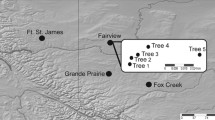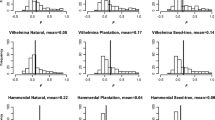Summary
Mating systems in two pairs of old-growth uncut and adjacent shelterwood stands of Douglas-fir (Pseudotsuga menziesii var. ‘menziesii’) were compared by estimating the proportions of viable progenies due to outcrossing (t) with both single-locus and multilocus techniques. Single-locus population estimates (ťs), ranging from 0.41 to 1.16, were significantly (P<0.05) heterogeneous among loci in three of four stands; mean single-locus estimates for shelterwoods were not significantly different from those for uncut stands. Multilocus population estimates (ťm) ranged from 0.94 to 1.00; again, estimates for shelterwoods were not significantly different from those for uncut stands. Multilocus estimates were slightly higher than mean single-locus estimates for uncut stands but were nearly equivalent for shelterwoods, suggesting that related matings other than selfs may be associated with uncut stands, but not shelterwoods. Individual-tree outcrossing rates (ťm i), estimated for six trees in each shelterwood, ranged from 0.90 to 1.10 and were significantly heterogeneous among trees at one of the two shelterwoods. Outcrossing was high (> 0.90) in both uncult and shelterwood stands, and no evidence indicated that low parent-tree density had affected stand outcrossing rates.
Similar content being viewed by others
References
Brown AHD, Matheson AC, Eldridge KG (1975) Estimation of the mating system of Eucalyptus obliqua L'Herit. by using allozyme polymorphisms. Aust J Bot 23:931–949
Brunk HD (1975) An introduction to mathematical statistics, 3rd edn. Xerox College Publishers, pp 457
Cheliak WM, Dancik BP, Morgan K, Yeh FCH, Strobeck C (1985) Temporal variation of the mating system in a natural population of jack pine. Genetics 109:569–584
Clegg MT (1980) Measuring plant mating systems. Bio Science 30:814–818
El-Kassaby YA, Yeh FC, Sziklai O (1981) Estimation of the outcrossing rate of Douglas-fir [Pseudotsuga menziesii (Mirb.) Franco] using allozyme polymorphisms. Silvae Genet 30:182–184
El-Kassaby YA, Yeh FC, Sziklai O (1982) Inheritance of allozyme variations in coastal Douglas-fir (Pseudotsuga menziesii var. ‘menziesii’). Can J Genet Cytol 24:325–335
Fyfe JL, Bailey NTJ (1951) Plant breeding studies in leguminous forage crops. 1. Natural cross-breeding in winterbeans. J Agric Sci 41:371–378
Green AG, Brown HAD, Oram RN (1980) Determination of outcrossing rate in a breeding population of Lupinus albus L. (white lupin). Z Pflanzenzücht 84:181–191
King JN, Dancik BP, Dhir NK (1984) Genetic structure and mating system of white spruce (Picea glauca) in a seed production area. Can J For Res 14:639–643
Levins R (1962) Theory of fitness in a heterogeneous environment. 1. The Fitness set and adaptive function. Am Nat 96:361–378
Levins R (1963) Theory of fitness in a heterogeneous environment. 2. Developmental flexibility and niche selection. Am Nat 97:75–90
Mitton JB, Linhart YB, Davis ML, Sturgeon KB (1981) Estimation of outcrossing in ponderosa pine, Pinus ponderosa Laws., from patterns of segregation of protein polymorphisms and from frequencies of albino seedlings. Silvae Genet 30:117–121
Moran GF, Brown AHD (1980) Temporal heterogeneity of outcrossing rates in alpine ash (Eucalyptus delegatensis R. T. Bak.). Theor Appl Genet 57:101–105
Neale DB (1984) Population genetic structure of the Douglas-fir shelterwood regeneration system in southwest Oregon. PhD Dissertation, Oregon State University, Corvallis. Diss Abstr LD4330-1984D-N4
Neale DB, Weber JC, Adams WT (1984) Inheritance of needle tissue isozymes in Douglas-fir. Can J Genet Cytol 26:459–468
Omi SK (1983) Seed set and the proportion of progeny due to self-fertilization in a Douglas-fir seed orchard. MS Thesis, Oregon State University, Corvallis
Orr-Ewing AL (1957) Further inbreeding studies with Douglas-fir. For Chron 33:318–332
Rao CR (1973) Linear statistical inference and its applications, 2nd edn. Wiley & Sons, New York, pp 625
Rehfeldt GE (1978) The genetic structure of a population of Douglas-fir (Pseudotsuga menziesii var. ‘glauca’) as reflected by its wind-pollinated progenies. Silvae Genet 27:49–52
Ritland K, Jain S (1981) A model for the estimation of outcrossing rate and gene frequencies using n independent loci. Heredity 47:35–52
Rudin D, Eriksson G, Rasmuson M (1977) Inbreeding in a seed tree stand of Pinus sylvestris L. in northern Sweden. A study by the aid of the isozyme technique. Res Note 25, Dept Forest Gent, Royal College of Forestry, pp 45
Shaw DV (1980) The mating system and breeding structure of Douglas-fir (Pseudotsuga menziesii var. ‘menziesii’). PhD Thesis, University of California, Davis
Shaw DV, Allard RW (1982) Estimation of outcrossing rates in Douglas-fir using isozyme markers. Theor Appl Genet 62:113–120
Shaw DV, Kahler AL, Allard RW (1981) A multilocus estimator of mating system parameters in plant populations. Proc Natl Acad Sci USA 78:1298–1302
Sorensen FC (1971) Estimate of self-fertility in coastal Douglas-fir from inbreeding studies. Silvae Genet 20:115–120
Sorensen FC (1973) Frequency of seedlings from natural self-fertilization in coastal Douglas-fir. Silvae Genet 22:20–24
Sorensen FC (1982) The roles of polyembryony and embryo viability in the genetic system of conifers. Evolution 36:725–733
Sorensen FC, Miles RS (1974) Self-pollination effects on Douglas-fir and ponderosa pine seeds and seedlings. Silvae Genet 23:135–138
Sorensen FC, Miles RS (1982) Inbreeding depression in height, height growth, and survival of Douglas-fir, ponderosa pine, and noble fir to 10 years of age. Forest Sci 28:283–292
Author information
Authors and Affiliations
Additional information
Communicated by A. L. Kahler
FRL 1918, Forest Research Laboratory. Oregon State University, Corvallis, USA
Rights and permissions
About this article
Cite this article
Neale, D.B., Adams, W.T. The mating system in natural and shelterwood stands of Douglas-fir. Theoret. Appl. Genetics 71, 201–207 (1985). https://doi.org/10.1007/BF00252056
Accepted:
Issue Date:
DOI: https://doi.org/10.1007/BF00252056




